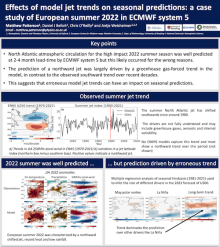Effects of model jet trends on seasonal predictions: a case study of European summer 2022
Matthew
Patterson
University of Oxford
Poster
Warming trends have long been known to contribute to seasonal prediction skill. In this study, we argue that model representation of climate change-induced trends in atmospheric circulation can also affect seasonal forecasts.
We focus on the Euro-Atlantic region which has been marked by a southward jet trend in observations over the past forty years. However, this jet trend is not captured by free-running climate models which, if anything, show a poleward shift over this time period. Some seasonal prediction systems, such as ECMWF’s SEAS5, also show a poleward trend in the summer North Atlantic jet over recent decades.
We investigate the European summer season in 2022, which was characterised by hot and dry conditions, with an anomalously northward shifted jet. These anomalies were well predicted by SEAS5 with part of the signal derived from a La Nina phase of the tropical Pacific ocean. However, we also find that the erroneous jet trend contributed to the correct anomaly pattern, but for the wrong reasons. We discuss the implications of this finding for prediction on seasonal and longer timescales.
We focus on the Euro-Atlantic region which has been marked by a southward jet trend in observations over the past forty years. However, this jet trend is not captured by free-running climate models which, if anything, show a poleward shift over this time period. Some seasonal prediction systems, such as ECMWF’s SEAS5, also show a poleward trend in the summer North Atlantic jet over recent decades.
We investigate the European summer season in 2022, which was characterised by hot and dry conditions, with an anomalously northward shifted jet. These anomalies were well predicted by SEAS5 with part of the signal derived from a La Nina phase of the tropical Pacific ocean. However, we also find that the erroneous jet trend contributed to the correct anomaly pattern, but for the wrong reasons. We discuss the implications of this finding for prediction on seasonal and longer timescales.

Poster file
